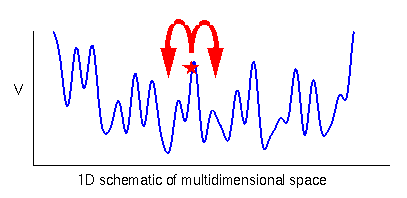Simulated annealing is a special case of either MD (`quenched' MD), LD, or MC simulation,
in which the temperature is gradually reduced during the simulation. Often, the system is first heated and then cooled.
Thus, the system is given the opportunity to surmount energetic barriers in a search for conformations with energies lower
than the local-minimum energy found by energy minimization.
This improved equilibration can lead to more realistic simulations of dynamics at low temperature [6].
Of course, annealing is more expensive than energy minimization.
Simulated annealing is often applied to potentials, ![]() , that include unphysical energy terms,
as when annealing structures to reduce crystallographic R factors.
, that include unphysical energy terms,
as when annealing structures to reduce crystallographic R factors.
 |
|---|
| Simulated annealing can overcome barriers by heating and cooling the system. |